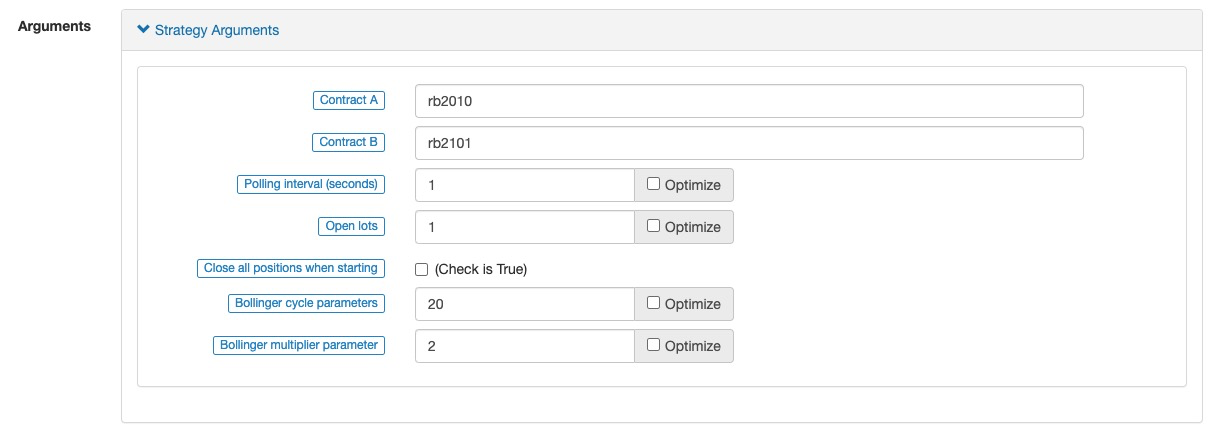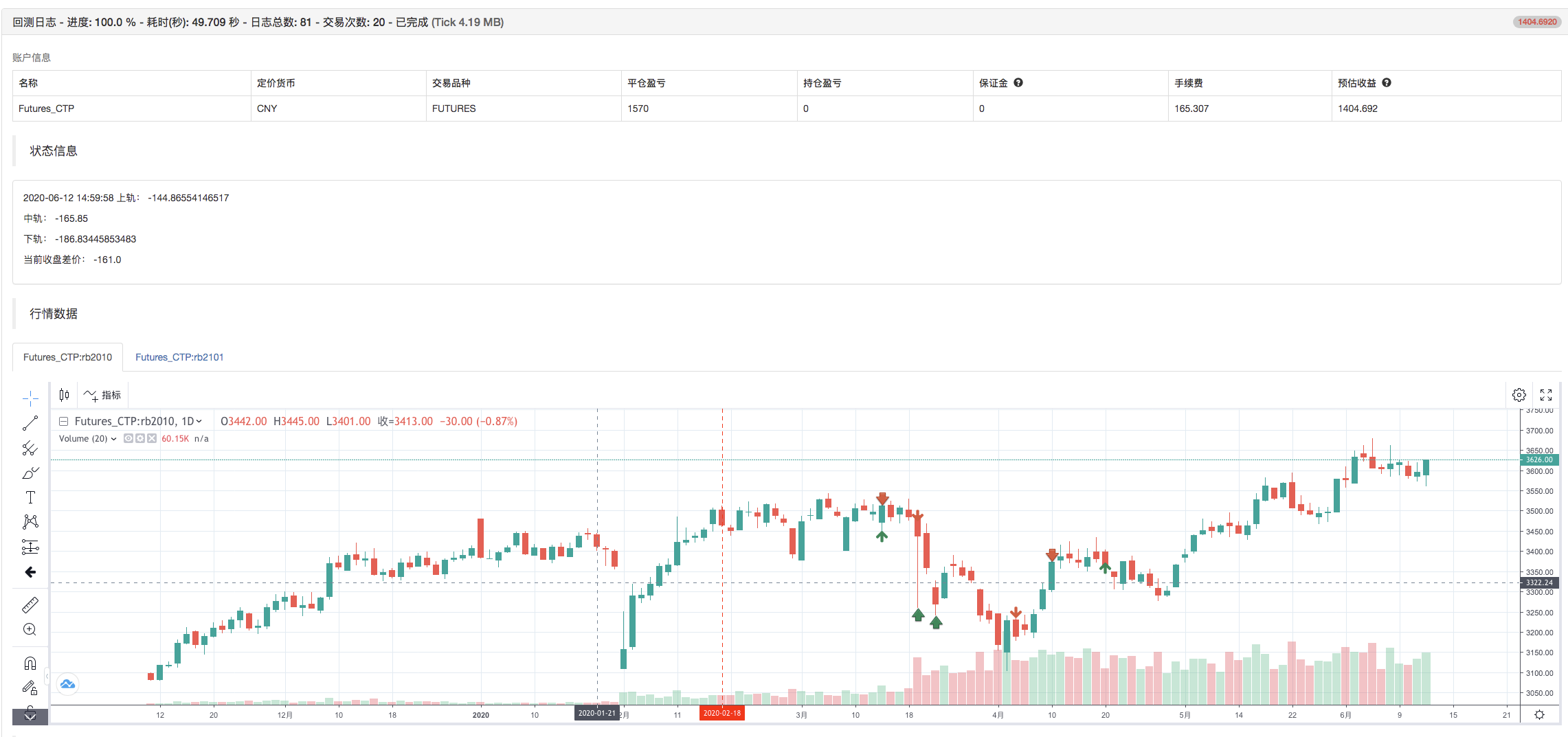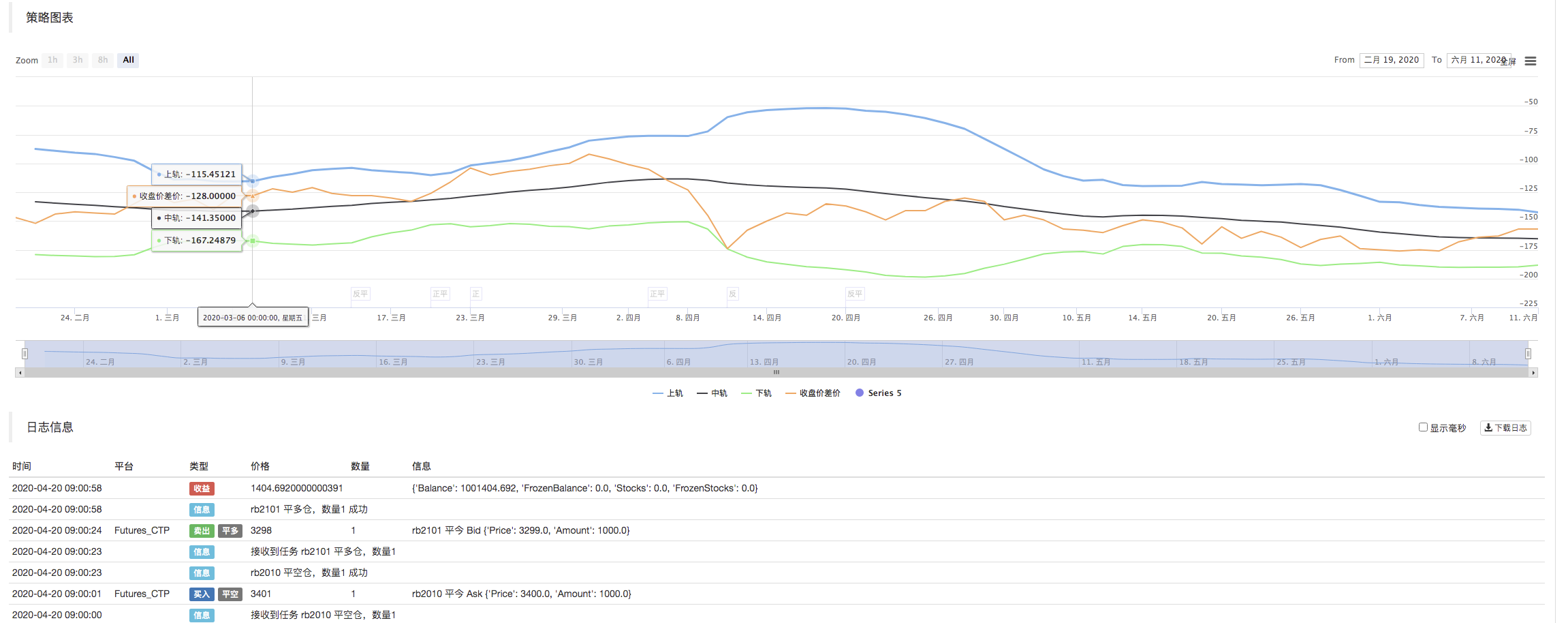La versión Python de la estrategia de cobertura intertemporal de Bollinger de futuros de materias primas (sólo para fines de estudio)
El autor:La bondad, Creado: 2020-06-20 10:52:34, Actualizado: 2023-10-31 21:05:21
La estrategia de arbitraje intertemporal previamente escrita requiere la entrada manual del spread de cobertura para la apertura y cierre de posiciones. Juzgar la diferencia de precio es más subjetiva. En este artículo, cambiaremos la estrategia de cobertura anterior a la estrategia de usar el indicador BOLL para abrir y cerrar posiciones.
class Hedge:
'Hedging control class'
def __init__(self, q, e, initAccount, symbolA, symbolB, maPeriod, atrRatio, opAmount):
self.q = q
self.initAccount = initAccount
self.status = 0
self.symbolA = symbolA
self.symbolB = symbolB
self.e = e
self.isBusy = False
self.maPeriod = maPeriod
self.atrRatio = atrRatio
self.opAmount = opAmount
self.records = []
self.preBarTime = 0
def poll(self):
if (self.isBusy or not exchange.IO("status")) or not ext.IsTrading(self.symbolA):
Sleep(1000)
return
insDetailA = exchange.SetContractType(self.symbolA)
if not insDetailA:
return
recordsA = exchange.GetRecords()
if not recordsA:
return
insDetailB = exchange.SetContractType(self.symbolB)
if not insDetailB:
return
recordsB = exchange.GetRecords()
if not recordsB:
return
# Calculate the spread price K line
if recordsA[-1]["Time"] != recordsB[-1]["Time"]:
return
minL = min(len(recordsA), len(recordsB))
rA = recordsA.copy()
rB = recordsB.copy()
rA.reverse()
rB.reverse()
count = 0
arrDiff = []
for i in range(minL):
arrDiff.append(rB[i]["Close"] - rA[i]["Close"])
arrDiff.reverse()
if len(arrDiff) < self.maPeriod:
return
# Calculate Bollinger Bands indicator
boll = TA.BOLL(arrDiff, self.maPeriod, self.atrRatio)
ext.PlotLine("upper trail", boll[0][-2], recordsA[-2]["Time"])
ext.PlotLine("middle trail", boll[1][-2], recordsA[-2]["Time"])
ext.PlotLine("lower trail", boll[2][-2], recordsA[-2]["Time"])
ext.PlotLine("Closing price spread", arrDiff[-2], recordsA[-2]["Time"])
LogStatus(_D(), "upper trail:", boll[0][-1], "\n", "middle trail:", boll[1][-1], "\n", "lower trail:", boll[2][-1], "\n", "Current closing price spread:", arrDiff[-1])
action = 0
# Signal trigger
if self.status == 0:
if arrDiff[-1] > boll[0][-1]:
Log("Open position A buy B sell", ", A latest price:", recordsA[-1]["Close"], ", B latest price:", recordsB[-1]["Close"], "#FF0000")
action = 2
# Add chart markers
ext.PlotFlag(recordsA[-1]["Time"], "A buy B sell", "Positive")
elif arrDiff[-1] < boll[2][-1]:
Log("Open position A sell B buy", ", A latest price:", recordsA[-1]["Close"], ", B latest price:", recordsB[-1]["Close"], "#FF0000")
action = 1
# Add chart markers
ext.PlotFlag(recordsA[-1]["Time"], "A sell B buy", "Negative")
elif self.status == 1 and arrDiff[-1] > boll[1][-1]:
Log("Close position A buy B sell", ", A latest price:", recordsA[-1]["Close"], ", B latest price:", recordsB[-1]["Close"], "#FF0000")
action = 2
# Add chart markers
ext.PlotFlag(recordsA[-1]["Time"], "A buy B sell", "Close Negative")
elif self.status == 2 and arrDiff[-1] < boll[1][-1]:
Log("Close position A sell B buy", ", A latest price:", recordsA[-1]["Close"], ", B latest price:", recordsB[-1]["Close"], "#FF0000")
action = 1
# Add chart markers
ext.PlotFlag(recordsA[-1]["Time"], "A sell B buy", "Close Positive")
# Execute specific instructions
if action == 0:
return
self.isBusy = True
tasks = []
if action == 1:
tasks.append([self.symbolA, "sell" if self.status == 0 else "closebuy"])
tasks.append([self.symbolB, "buy" if self.status == 0 else "closesell"])
elif action == 2:
tasks.append([self.symbolA, "buy" if self.status == 0 else "closesell"])
tasks.append([self.symbolB, "sell" if self.status == 0 else "closebuy"])
def callBack(task, ret):
def callBack(task, ret):
self.isBusy = False
if task["action"] == "sell":
self.status = 2
elif task["action"] == "buy":
self.status = 1
else:
self.status = 0
account = _C(exchange.GetAccount)
LogProfit(account["Balance"] - self.initAccount["Balance"], account)
self.q.pushTask(self.e, tasks[1][0], tasks[1][1], self.opAmount, callBack)
self.q.pushTask(self.e, tasks[0][0], tasks[0][1], self.opAmount, callBack)
def main():
SetErrorFilter("ready|login|timeout")
Log("Connecting to the trading server...")
while not exchange.IO("status"):
Sleep(1000)
Log("Successfully connected to the trading server")
initAccount = _C(exchange.GetAccount)
Log(initAccount)
def callBack(task, ret):
Log(task["desc"], "success" if ret else "failure")
q = ext.NewTaskQueue(callBack)
p = ext.NewPositionManager()
if CoverAll:
Log("Start closing all remaining positions...")
p.CoverAll()
Log("Operation complete")
t = Hedge(q, exchange, initAccount, SA, SB, MAPeriod, ATRRatio, OpAmount)
while True:
q.poll()
t.poll()
Configuración de parámetros de estrategia:

El marco general de la estrategia es básicamente el mismo que el de laVersión Python de la estrategia de cobertura intertemporal de futuros de materias primasCuando la estrategia se ejecuta, se obtienen los datos de la línea K de los dos contratos, y luego se calcula la diferencia de precio para calcular el diferencial.TA.BOLLCuando el spread exceda el carril superior de la banda de Bollinger, será cubierto, y cuando toque el carril inferior, se opondrá al funcionamiento.
Prueba posterior:



Este artículo se utiliza principalmente sólo para fines de estudio. Estrategia completa:https://www.fmz.com/strategy/213826
- Cuantificar el análisis fundamental en el mercado de criptomonedas: ¡Deja que los datos hablen por sí mismos!
- La investigación cuantitativa básica del círculo monetario - ¡No confíes más en los profesores de idiomas, los datos hablan objetivamente!
- Una herramienta esencial en el campo de la transacción cuantitativa - inventor de módulos de exploración de datos cuantitativos
- Dominarlo todo - Introducción a FMZ Nueva versión de la terminal de negociación (con el código fuente de TRB Arbitrage)
- Conozca todo acerca de la nueva versión del terminal de operaciones de FMZ (con código de código de TRB)
- FMZ Quant: Análisis de ejemplos de diseño de requisitos comunes en el mercado de criptomonedas (II)
- Cómo explotar robots de venta sin cerebro con una estrategia de alta frecuencia en 80 líneas de código
- Cuantificación FMZ: Desarrollo de casos de diseño de necesidades comunes en el mercado de criptomonedas (II)
- Cómo utilizar una estrategia de alta frecuencia de 80 líneas de código para explotar y vender robots sin cerebro
- FMZ Quant: Análisis de ejemplos de diseño de requisitos comunes en el mercado de criptomonedas (I)
- Cuantificación FMZ: Desarrollo de casos de diseño de necesidades comunes en el mercado de criptomonedas (1)